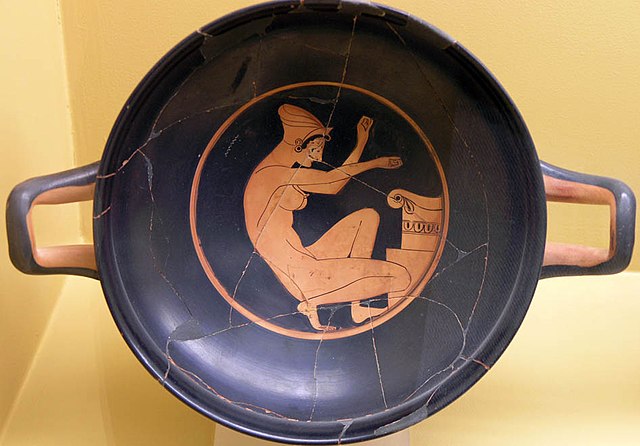The status and characteristics of ancient and modern-day women in Greece evolved from the events that occurred in the history of Greece. According to Michael Scott, in his article "The Rise of Women in Ancient Greece", "place of women" and their achievements in ancient Greece was best described by Thucidydes in this quotation: that "The greatest glory [for women] is to be least talked about among men, whether in praise or blame." However, the status of Greek women has undergone change and more advancement upon the onset of the twentieth century. In 1952, they received their right to vote, which led to their earning places and job positions in businesses and in the government of Greece; and they were able to maintain their right to inherit property, even after being married.
Ellie Lambeti, Greek actress
Two Women of Archaic Athens making preparations for a wedding, Displayed on ceramic painting from the 5th century BC
Woman kneeling before an altar. Attic red-figure kylix, 5th BC, Stoa of Attalos
A depiction of in the women's quarters of a house, on a classical Greek vase. The photo is focused on a seated woman who is relaxed while fingering a "barbiton" (a stringed instrument).
Women in classical Athens
The study of the lives of women in classical Athens has been a significant part of classical scholarship since the 1970s. The knowledge of Athenian women's lives comes from a variety of ancient sources. Much of it is literary evidence, primarily from tragedy, comedy, and oratory; supplemented with archaeological sources such as epigraphy and pottery. All of these sources were created by—and mostly for—men: there is no surviving ancient testimony by classical Athenian women on their own lives.
The Grave Stele of Hegeso (c.410–400 BC) is one of the best surviving examples of Attic grave stelae. Beginning around 450, Athenian funerary monuments increasingly depicted women as their civic importance increased.
Athenian girls would have played with dolls as children. Plangon, the young girl on this grave stele, carries a doll in her right hand.
Marriage was considered the most important part of a free Athenian woman's life. This box, known as a pyxis, would have been used to hold a woman's jewellery or cosmetics and is decorated with a wedding-procession scene.
Though respectable Athenian women were expected to stay out of the public eye, responsibilities such as fetching water from the fountain house on the edge of the agora would have brought them out of the house.








